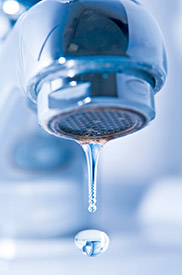Donít Let Little Leaks Become Big Problems
Do you have a leaky faucet or a drippy roof? Does your toilet run, or do you turn on the hot water only to get a cold shower? Little leaks can cause more than just frustration; left unattended, they can add up on your utility bill and ultimately turn into a costly repair.
Research shows that the typical home can lose 2,000 to 20,000 gallons of water every year due to leaks. Some leaks are obvious, such as from pipes and plumbing fixtures and fittings, but many can go undetected because the source isnít visible.
Even your water meter may not detect large leaks or a combination of small leaks. To see if you have an ďundetectedĒ leak, you can try this simple test: Turn off all water inside and outside your home, record the meter reading, wait 15 minutes, and then record a second reading to see if there is recorded water use.
If you do have a leak, you can call a plumber or professional contractor. Or if you are handy you can keep up with minor household leaks yourself.
Here are a few tips for detecting and repairing common household leaks:
- Dripping faucets: The main cause is worn-out washers, which are made of rubber and are inside the faucet handles. Replace washers by turning off the main water supply, unscrewing the leaky handle, and removing and replacing the washers.
- Running toilet: This can damage the bathroom floor and wear down the toilet’s internal workings. To find out if the tank is leaking, add some red food coloring to the water in the tank, then wait one hour and check if the water in the bowl is pink. If it is, there is a leak, and the flapper may need to be replaced. To change the flapper, shut off the water supply to the toilet by turning off the water valve behind the toilet. Remove the tank lid and flush the toilet to empty the tank and then mop out any excess water. Remove the flush chain from the level, slide the old flapper up off the overflow tube, and put in the new flapper. Then simply reconnect the chain and turn the water supply back on.
- Washing machine: Check water supply hoses for leaks at least once a year. If they’re plastic, replace them every three years. Look for any discoloration or rust in the drain hoses which means it’s time to replace them. Check the snugness of the drain lines and tighten them with a crescent wrench or pair of pliers if they are loose.
- Water heater: Drain the water at least once a year. To do this, turn off the water supply and power to the water heater. Then connect a water hose to the drain fitting at the bottom of the tank and put the other end someplace where you can safely drain the water, such as the driveway. Turn on all of the hot water faucets in your home, open the drain valve on the water heater, and turn the water supply back on to remove any sediment that may have built up on the bottom of the tank. When you’re done, close the drain valve, refill the tank, and turn the power back on.
- Plumbing: As a first step, never pour fats or other oils down the drain, which are the main cause of clogs. If you do have a clog, use a small drain snake to pull out the clogged material. If a pipe needs to be repaired, turn off the water supply, clean the pipe with fine sandpaper, and put sealing plumber’s tape on the area of the leak, wrapping it tightly several times.
- Leaky roof and gutters: Clean the gutters annually by physically removing debris and rinsing them clean using a garden hose. Make sure the gutters are properly affixed to the fascia boards and replace any sections that are damaged or have leaks. For the roof, periodically check the shingles for damage, discoloration, or loss of gravel and replace them. If you have a leak, look for curled or missing shingles in the area of the leak and for any exposed roofing tacks. Replace as necessary.
Call a professional if your repairs arenít holding, or the problem is larger than a simple drip or a small patch.
|
 |
 |
|
|
You can trust your
Reliance First Capital
mortgage analyst because theyíve been put through rigorous testing and background checks by the Federal Government, State Governments and by our organization. Also, every one of
our mortgage analysts are registered with the National Mortgage Licensing System (NMLS).
In addition, any information collected by our mortgage analysts are entered into and kept in our secure password-protected proprietary loan origination system, so you can be sure your information is safe.
Finally, you can verify our company by visiting:
HUD: click here
Company Web Site:
Licenses or Testimonials
 |
|
|
|
